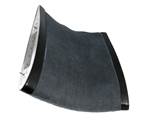Shape shifters: The molecular basics
The key to SMP shape change is the fact that an SMP can exhibit a radical transformation from a rigid polymer to a malleable elastomer and back again.
The key to SMP shape change is the fact that an SMP can exhibit a radical transformation from a rigid polymer to a malleable elastomer and back again. SMP researcher Thorsten Pretsch of BAM Federal Institute for Materials Research and Testing (Berlin, Germany), explains that, on the molecular level, SMPs are “polymer networks with integrated, stimuli-sensitive switches. Suitable polymer network architectures consist of chain segments and netpoints. Since the netpoints crosslink the chain segments, they determine the permanent shape of the polymer. The crosslinks can be either of chemical nature (covalent bonds) or physical nature (intermolecular interactions like crystals and chain entanglements); they prevent flow of the molecular chains under deformation.”
A thermally activated SMP shifts between its rigid and elastic state at its glass transition temperature (Tg). According to Cornerstone Research Group (CRG, Dayton, Ohio), the SMP can be formulated with a Tg that matches an application need. By triggering polymer molecule chain segments that have a specific Tg, the material can be deformed, and this deformed shape is maintained when the material is cooled. Once the material is heated above its Tg again, its “memory” kicks in and it returns to its original shape.
SMPs can be either thermoset or thermoplastic. “In general, thermoset SMPs have higher stiffness and lower strain capability than thermoplastic SMPs, which are easy to reshape, since they have no covalent bonds between chains,” says Pretsch.
Related Content
-
Revisiting the double vacuum debulk process
Evolution of the double vacuum debulk (DVD) process over the years continues to advance its “near autoclave quality” for low-void, highly compacted repair patches.
-
Composites end markets: Sports and recreation (2025)
The use of composite materials in high-performance sporting goods continues to grow, with new advancements including thermoplastic and sustainability-focused materials and automated processes.
-
Plasma moves beyond improved bonding to coatings, multifunctional composites
Plasmatreat cold plasma systems clean, activate surfaces and apply nanocoatings for dielectric barriers and more.



